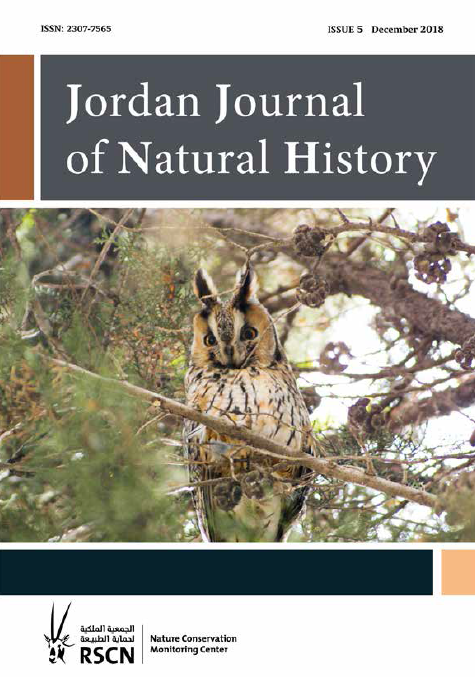Geological evolution of the Azraq basin, eastern Jordan: An overview
Author Name
Abdulkader M. Abed
The Azraq basin is some 100 Km east of Amman, the capital of Jordan. Hydrologically, it occupies ~12700Km2, mostly in Jordan, but it also extends to southern Syrian and NW Saudi Arabia. The Azraq area seems to have developed as a basin during the Paleozoic testified by the total thickness of both Ram and Khreim Groups in the Azraq subsurface being slightly less than twice those in the southern outcrops. In this case, the Azraq basin is similar to the Wadi Sirhan basin. From the Carboniferous, Late Paleozoic, to the top Ajlun Group, Mid Cretaceous, no basinal development took place in the Azraq area. Dramatic changes seem to have taken place in the Azraq basin during the deposition of the Belqa Group. Northwest-trending faults became active since the Coniacian? such as the Fuluk Fault and Rajil Fault. A subsiding graben, called Hamza Graben, was the scene for a thick, fast sedimentation of more than 2000m during the Coniacian-Campanian represented by the Rajil, Hamza and Hazim Formation which are dominated by carbonates. This is explained by synsedimentary deposition in a subsiding basin. The basin continued up till the Eocene albeit being at a slower rate during the rest of the Belqa Group. By the end of the Eocene, the Neo-Tethys Ocean had migrated from the eastern Mediterranean and the Azraq area, as well as almost all Jordan, and the area became terrestrial, and subjected to erosion. The Azraq basin continued as a depression where lake deposits formed from the Miocene onwards. The large recharging area of the Azraq depression seems to have ensured enough water for the marches and springs of the Azraq oasis even in the driest climates in the past, which made the oasis a refugia for hominins and animals throughout the Pleistocene time.
Macrofaunal Fossil Assemblage from Beit Ummar, Hebron, Palestine
Author Name
Taleb Al-Harithi, Mazin B. Qumsiyeh, and Elias N. Handal
Eighteen molluscan and echinoderm elements comprising eleven Bivalvia, three Gastropoda, two Cephalopoda and two Echinoidea are described from a marl bed outcropping in the northern part of Beit Ummar, Hebron District, Palestine. This fossil community belongs to the Middle Cenomanian time and is similar to nearby macrofaunal assemblages in the Eastern Mediterranean region. The species extracted indicate a shallow marine warm environmental condition that prevailed in the sea at that time frame in what is now the Hebron Hills.
Status of the Nubian nightjar (Camprimulgus nubicus) In Fifa Nature Reserve (Ramsar site)
Author Name
Abdullah Al Oshoush
Fifa Nature Reserve was recently established by the Royal Society for the Conservation of Nature (RSCN) that proves to be an important site for several bird species in the Middle East. The reserve is home to a resident population of the Nubian nightjar (Caprimulgus nubicus), which is critically endangered in Jordan. The first and only survey of this species to date was conducted in 2014, three years after the establishment of the reserve. This study provides an updated estimate of the Nubian nightjar population, while assessing some potential factors that may influence activity and breeding habits of the species within the reserve. Using spot counts, we recorded 63 calls of male Nubian nightjars; a 24 % increase from the 2014 study. We also provide the first confirmation of breeding of this species within the reserve by nest observations. Twenty-one nests were located, three of which were proven to be active. Distances to agriculture and vegetation community were not found to influence the number of Nubian nightjar calls recorded. However, all of the nests that we recorded were located in habitat dominated by Tamarix tetragyna and within 100 m of agriculture. Nesting data were too sparse for statistical analyses, however, we suggest that further attention be paid to breeding habits by conducting a more extensive nesting survey during the breeding period.
Shoreline encounter and stranding rates of cetaceans and loggerhead turtles Caretta caretta in North Sinai, Egypt
Author Name
Basem Rabia and Omar Attum
Eight species of cetaceans and two species of marine turtles regularly occur in the Mediterranean Sea, with the eastern basin of the Mediterranean being considered among the least studied. The objective of this study was to carry out a shoreline cetacean and marine turtle survey in North Sinai, Egypt as part of a citizen science program between 7/2/18 – 8/30/18. We had fifty-five encounters of the common bottlenose dolphin, Tursiops truncates in twenty groups with an average of 2.5 (SE + 0.32, Range 1 - 6) individuals seen per group, one striped dolphin, Stenella coeruleoalba, and one short beaked common dolphin, Delphinus delphis, from the shore. In addition, a fisherman reported an observation of a Cuvier’s beaked whale, Ziphius cavirostris, from several kilometers from the shore. We observed six stranded common bottlenose dolphins, with a rough average of a stranding occurring every 10 days. We recorded no live observations of loggerhead turtles, Caretta caretta but did record nine dead, stranded turtles, for an average of a stranding occurring roughly every seven days. Our shoreline observations of rare cetaceans and the relatively frequent strandings of common bottlenose dolphins and loggerhead turtles suggests that there are resident summer populations and that the eastern basin of the Mediterranean may not be as biologically poor in sea turtle and cetaceans populations as originally thought.
First record of breeding of the Long-eared Owl, Asio otus in Jordan
Author Name
Ratib M. Al Oran
The Long-eared Owl (Asia otus) is a medium-sized nocturnal species with distinct erect, blackish ear-tufts. It has a broad distribution across the northern latitudes of North America, Europe, Eurasia, and the Levant (Cramp and Simmons, 1985). It prefers forests close to open country, edges of semi-open woodland and urban areas (Cramp and Simmons, 1985). It is known as an opportunist feeder and takes a high diversity of small-sized prey (Birrer, 2009). This owl is considered as an uncommon winter visitor in Jordan (Andrews, 1995). Along its global distribution, diet have been extensively studied in North America and Europe, yet, reports on its ecology and diet within the most southern limits of its distribution are under-represented and far from satisfactory (Birrer, 2009). Only recently, Obuch (2018) reported on the diet of this owl in Jordan, including localities from the Mediterranean bioclimatic region (Amman, Marj al—Hammam, Wasfi Al Tal forest and Dibbin forests), while reported from arid regions including Shaumari and Mafraq Jordan sits at the most southern edge of distribution of the Long-eared Owl, yet no studies have been conducted to establish evidence to its breeding in Jordan.




